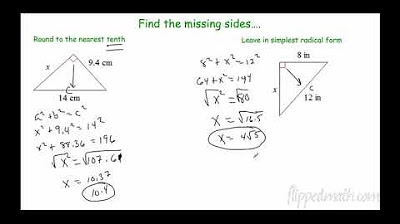Finding the Original Price Given the Sale Price and Percent Discount | Math with Mr. J
Summary
TLDRIn the 'Math with Mr. J' video, the host teaches viewers how to calculate the original price of an item given its sale price and the discount percentage. Using two examples, he demonstrates the method of setting up an equation where the original price times (100 minus the discount percent) equals the sale price. He explains converting percentages to decimals and solving for the original price through division. The first example finds an original price of $85 for an item sold at $59.50 with a 30% discount. The second example calculates an original price of $249.80 for an item sold at $112.41 with a 55% discount. The video is educational, providing a clear step-by-step approach to solving such problems.
Takeaways
- 🧮 The video explains how to calculate the original price given the sale price and the discount percentage.
- 🔢 The formula used is: Original Price × (100% - Discount %) = Sale Price.
- ✏️ In Example 1, the sale price is $59.50 with a 30% discount, so the equation becomes: Original Price × 70% = 59.50.
- ➗ 100% - 30% equals 70%, which represents the percentage of the original price being paid after the discount.
- 💡 To simplify the equation, convert the percentage to a decimal (70% = 0.70).
- ✂️ After isolating the variable for the original price, the final step is dividing the sale price by the percentage in decimal form: $59.50 ÷ 0.70 = $85.
- 💲 In Example 2, the sale price is $112.41 with a 55% discount, so the equation becomes: Original Price × 45% = 112.41.
- 🔄 100% - 55% equals 45%, so you pay 45% of the original price in this example.
- 🧑🏫 Convert 45% to a decimal (0.45) and divide the sale price by this decimal: $112.41 ÷ 0.45 = $249.80.
- 🎯 The video walks through step-by-step examples to help viewers understand how to reverse the discount to find the original price.
Q & A
What is the purpose of the video?
-The purpose of the video is to teach viewers how to calculate the original price of an item given its sale price and the discount percentage.
What is the first example's sale price in the video?
-The first example's sale price is $59.50.
What discount percentage is used in the first example?
-The discount percentage used in the first example is 30%.
How does the video represent the original price mathematically?
-The video represents the original price with the variable 'p' and sets up an equation using the formula: original price * (100 - discount percent) = sale price.
What does the conversion of 70 percent to a decimal involve?
-The conversion of 70 percent to a decimal involves moving the decimal point two places to the left, resulting in 0.70.
What is the equation used to find the original price in the first example?
-The equation used to find the original price in the first example is p * 0.70 = $59.50.
How is the original price isolated in the equation?
-The original price is isolated by dividing both sides of the equation by 0.70.
What is the calculated original price for the first example?
-The calculated original price for the first example is $85.
What is the sale price in the second example discussed in the video?
-The sale price in the second example is $112.41.
What discount percentage is used in the second example?
-The discount percentage used in the second example is 55%.
How is the original price calculated in the second example?
-The original price in the second example is calculated by dividing the sale price of $112.41 by 0.45 (the decimal equivalent of 45%).
What is the final original price found in the second example?
-The final original price found in the second example is $249.80.
Outlines

This section is available to paid users only. Please upgrade to access this part.
Upgrade NowMindmap

This section is available to paid users only. Please upgrade to access this part.
Upgrade NowKeywords

This section is available to paid users only. Please upgrade to access this part.
Upgrade NowHighlights

This section is available to paid users only. Please upgrade to access this part.
Upgrade NowTranscripts

This section is available to paid users only. Please upgrade to access this part.
Upgrade NowBrowse More Related Video

The First Day of High School: Establishing Classroom Expectations and Building Relationships

Order of Operations: A Step-By-Step Guide | PEMDAS | Math with Mr. J

Jejak Matematika di Berbagai Budaya: Etnomatematika dalam Kehidupan Sehari-hari

Solving Two-Step Equations | Algebra Equations

(BOCORAN) SOAL TES MASUK SMP/MTs‼️PART 1

Lisa, wake up! - Conversation in English - English Communication Lesson

Geometry – 7.1 Pythagorean Theorem and Its Converse
5.0 / 5 (0 votes)